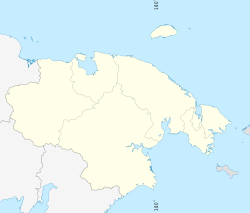Iultin
| Former settlement
Iultin
Иультин
|
||||||||||||||||||
|
||||||||||||||||||
|
||||||||||||||||||
Iultin ( Russian Иульти́н ) is a former urban-type settlement in the Chukchi Autonomous Okrug in the far northeast of Russia . With the abandonment of the place in the second half of the 1990s, Iultin became a “ ghost town ”.
geography
The settlement is located in the northern central part of the Chukchi Peninsula , north of the Arctic Circle in the valley of the Iultinka in the river system of the Koiwelwegyrgyn (Russian and Chukchi Койвэльвэгыргын ) flowing into the Chukchi Sea . It is surrounded by the mountains of the Ekwywatap Mountains, which rise to almost 1200 m .
Iultin belongs to the Iultin Rajon named after the settlement, but was never its administrative center.
history
In 1937 a significant deposit of tin , tungsten and molybdenum ores was discovered in the vicinity of the later settlement . However, their development did not begin until after the end of the Second World War . Starting in 1946 , a 200-kilometer road was built from the Egwekinot settlement on the coast of the Bering Sea , where a port was established for this purpose . In 1953 the deposit was reached and the place Iultin was founded. During the construction of the settlement, the road and the mine, prisoners from a camp were used which was subordinate to the Far Eastern camp administration ( Dalstroi ) in the Gulag system . The camp existed until 1956.
A little later, the settlement received the status of an urban-type settlement; the mining of the ores began in 1959. A work for the enrichment of the ores (Iultinski GOK) was built near the place . The ores from the Swetloje deposit, located a good 20 kilometers to the north, discovered in the 1950s, explored in the 1960s and mined from 1976 onwards, were also processed there. The mostly unpaved road to Iultin, which initially leads over a nearly 500 meter high pass into the valley of the Amguema , one of the largest rivers on the peninsula, and crosses it, was later made by Iultin in the form of a track that can be driven with off-road vehicles over more than 100 more Kilometers extended to the settlement of Mys Schmidta on the north coast of the Chukotka peninsula.
Under the difficult economic conditions in the period of the collapse of the Soviet Union in the early 1990s, ore mining and processing in the remote settlement became unprofitable; the mine and the enrichment plant had to close. On December 4, 1995, the government of the Russian Federation decided to give up the Iultin settlement. The last inhabitants left the place in 2000.
Population development
| year | Residents |
|---|---|
| 1959 | 2513 |
| 1970 | 4033 |
| 1979 | 4115 |
| 1989 | 5301 |
Note : census data
Sons and daughters of the place
- Kostjantyn Schewaho (* 1974), Ukrainian politician and entrepreneur
Individual evidence
- ↑ Tschuktschen-ITL in the GULAG Internet portal of Memorial Deutschland e. V.
- ↑ Gornaja ėncyklopedija . tape 2 . Sovetskaja ėncyklopedija, Moscow 1986, p. 477 ( Mining Encyclopedia , Russian).
- ↑ Order No. 1188 of the Government of the Russian Federation on measures to stabilize the socio-economic situation in the Chukchi Autonomous Okrug and the social protection of the population of the Iultin settlement dated December 4, 1995 (Russian)
Web links
- Iultin photo gallery (status around 2005–2009)

